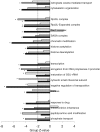Genome-wide analysis of yeast stress survival and tolerance acquisition to analyze the central trade-off between growth rate and cellular robustness
- PMID: 21965291
- PMCID: PMC3216668
- DOI: 10.1091/mbc.E10-08-0721
Genome-wide analysis of yeast stress survival and tolerance acquisition to analyze the central trade-off between growth rate and cellular robustness
Abstract
All organisms have evolved to cope with changes in environmental conditions, ensuring the optimal combination of proliferation and survival. In yeast, exposure to a mild stress leads to an increased tolerance for other stresses. This suggests that yeast uses information from the environment to prepare for future threats. We used the yeast knockout collection to systematically investigate the genes and functions involved in severe stress survival and in the acquisition of stress (cross-) tolerance. Besides genes and functions relevant for survival of heat, acid, and oxidative stress, we found an inverse correlation between mutant growth rate and stress survival. Using chemostat cultures, we confirmed that growth rate governs stress tolerance, with higher growth efficiency at low growth rates liberating the energy for these investments. Cellular functions required for stress tolerance acquisition, independent of the reduction in growth rate, were involved in vesicular transport, the Rpd3 histone deacetylase complex, and the mitotic cell cycle. Stress resistance and acquired stress tolerance in Saccharomyces cerevisiae are governed by a combination of stress-specific and general processes. The reduction of growth rate, irrespective of the cause of this reduction, leads to redistribution of resources toward stress tolerance functions, thus preparing the cells for impending change.
Figures







Similar articles
-
Genome-wide identification of genes involved in tolerance to various environmental stresses in Saccharomyces cerevisiae.J Appl Genet. 2009;50(3):301-10. doi: 10.1007/BF03195688. J Appl Genet. 2009. PMID: 19638689
-
Comparative transcriptome profiling analyses during the lag phase uncover YAP1, PDR1, PDR3, RPN4, and HSF1 as key regulatory genes in genomic adaptation to the lignocellulose derived inhibitor HMF for Saccharomyces cerevisiae.BMC Genomics. 2010 Nov 24;11:660. doi: 10.1186/1471-2164-11-660. BMC Genomics. 2010. PMID: 21106074 Free PMC article.
-
The InsP7 phosphatase Siw14 regulates inositol pyrophosphate levels to control localization of the general stress response transcription factor Msn2.J Biol Chem. 2020 Feb 14;295(7):2043-2056. doi: 10.1074/jbc.RA119.012148. Epub 2019 Dec 17. J Biol Chem. 2020. PMID: 31848224 Free PMC article.
-
Cross-stress resistance in Saccharomyces cerevisiae yeast--new insight into an old phenomenon.Cell Stress Chaperones. 2016 Mar;21(2):187-200. doi: 10.1007/s12192-016-0667-7. Epub 2016 Jan 29. Cell Stress Chaperones. 2016. PMID: 26825800 Free PMC article. Review.
-
Stress-tolerance of baker's-yeast (Saccharomyces cerevisiae) cells: stress-protective molecules and genes involved in stress tolerance.Biotechnol Appl Biochem. 2009 May 29;53(Pt 3):155-64. doi: 10.1042/BA20090029. Biotechnol Appl Biochem. 2009. PMID: 19476439 Review.
Cited by
-
Transcriptional Rewiring, Adaptation, and the Role of Gene Duplication in the Metabolism of Ethanol of Saccharomyces cerevisiae.mSystems. 2020 Aug 11;5(4):e00416-20. doi: 10.1128/mSystems.00416-20. mSystems. 2020. PMID: 32788405 Free PMC article.
-
Quantification of Microbial Robustness in Yeast.ACS Synth Biol. 2022 Apr 15;11(4):1686-1691. doi: 10.1021/acssynbio.1c00615. Epub 2022 Mar 11. ACS Synth Biol. 2022. PMID: 35276039 Free PMC article.
-
Independent Mechanisms for Acquired Salt Tolerance versus Growth Resumption Induced by Mild Ethanol Pretreatment in Saccharomyces cerevisiae.mSphere. 2018 Nov 28;3(6):e00574-18. doi: 10.1128/mSphere.00574-18. mSphere. 2018. PMID: 30487155 Free PMC article.
-
Yeast metabolic and signaling genes are required for heat-shock survival and have little overlap with the heat-induced genes.Proc Natl Acad Sci U S A. 2013 Nov 12;110(46):E4393-402. doi: 10.1073/pnas.1318100110. Epub 2013 Oct 28. Proc Natl Acad Sci U S A. 2013. PMID: 24167267 Free PMC article.
-
Evolutionary and Biochemical Aspects of Chemical Stress Resistance in Saccharomyces cerevisiae.Front Genet. 2012 Mar 30;3:47. doi: 10.3389/fgene.2012.00047. eCollection 2012. Front Genet. 2012. PMID: 22479268 Free PMC article.
References
-
- Attfield PV. Trehalose accumulates in Saccharomyces cerevisiae during exposure to agents that induce heat shock response. FEBS Lett. 1987;225:259–263. - PubMed
-
- Attfield PV, Choi HY, Veal DA, Bell PJ. Heterogeneity of stress gene expression and stress resistance among individual cells of Saccharomyces cerevisiae. Mol Microbiol. 2001;40:1000–1008. - PubMed
-
- Balaban NQ, Merrin J, Chait R, Kowalik L, Leibler S. Bacterial persistence as a phenotypic switch. Science. 2004;305:1622–1625. - PubMed
-
- Beck T, Hall MN. The TOR signalling pathway controls nuclear localization of nutrient-regulated transcription factors. Nature. 1999;402:689–692. - PubMed
Publication types
MeSH terms
Substances
Grants and funding
LinkOut - more resources
Full Text Sources
Molecular Biology Databases

